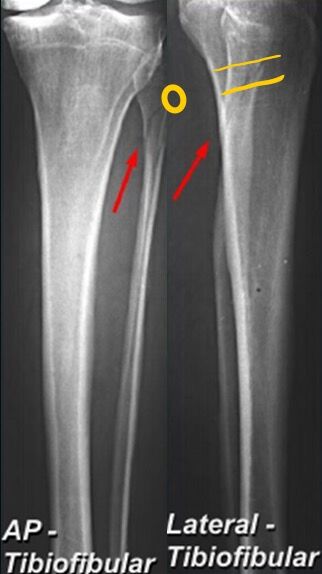Foot Drop Caused by Injury to Common Peroneal Nerve
Edward suffered a severe Maisonneuve fracture of the left leg. The injury occurred when he planted his left leg hard on the steeply inclined surface of a mountainside. He states that he felt his ankle and leg give way and he became immediately aware of severe deficits in his ability to extend the left ankle and toes.

X-ray showing proximal fibular fracture component of a maisonneuve injury. The yellow indicates the position of the common peroneal nerve in relation to the fibula. Injury to this nerve causes severe foot drop.*
Edward underwent surgery distally to pin the fibula to the tibia but did not have any surgical intervention for the proximal fibular fracture.
After healing from the orthopedic injuries, Edward was left with almost a complete foot drop on the left. He had very little ability to extend the left ankle and could not raise the left great toe at all. With no control over the great toe, he started to develop severe blisters from his shoes.
The reason for Edward’s foot drop after his injury was a compression of the left common peroneal nerve. The common peroneal nerve passes through a tight space between the shaft of the fibula bone and a tough tendinous band on the deep side of the peroneus longus muscle belly. When the fibula fractured it significantly reduced this already small space, resulting in severe compression of the common peroneal nerve and leading to an almost instant foot drop.
When this type of injury occurs, doctors are confused. Their response is to recommend taking a wait-and-see approach. This sets up a game of chance for the patient. If their nerve injury is mild, it will probably resolve on its own. If the nerve injury is more severe, everyone just waits, and waits, and waits, until the time window to operate and correct the damage has passed.
Luckily in Edward’s case, he was referred to Dr. Tollestrup relatively early in the course of his nerve injury.
Edward underwent an immediate surgical procedure to relieve the pressure on the common peroneal nerve. He has now regained full strength in the ankle and is on is way to regaining full strength in the great toe. His foot drop is no longer clinically significant. He has good control of the great toe back which has stopped the blistering and severe ingrown toenails.
Here is a video Dr. Tollestrup took with Edward showing how far he has come.
If you or someone you know is suffering from a foot drop, compression of the common peroneal nerve might be the problem. If it is, Dr. Tollestrup can help. Please call the office to schedule a consultation.
*Disclaimer
We do not guarantee any specific results or outcomes for surgery, should our practice work on your behalf. Information on this website may be used as a reference for successes we’ve achieved for our patients, and not as an assurance or guarantee for similar results in all instances.
